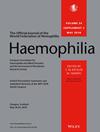Haemophilia's Heartland: Pain, Poverty and Patient Care in Faisalabad
Abstract
Introduction
Haemophilia is an inherited bleeding disorder that causes significant pain and disability. Haemophilia A and B are the most common, with HemA affecting more men and being four times more prevalent.
Methods
A cross-sectional study was conducted in Faisalabad, Pakistan, to assess pain severity in haemophilia patients based on sociodemographic factors and management approaches. Data were collected through structured interviews and analysed using SPSS version 27.0, examining associations between variables and pain severity.
Results
A sample of 200 patients was selected from the 800 registered patients at a haemophilia treatment centre (HTC) in Faisalabad. All participants had severe haemophilia, with 65.5% residing in rural areas. Severe pain was reported by 58% of patients, with higher prevalence among rural residents (35% vs. 22.5% urban, p = 0.004) and those with monthly income below Rs. 15,000 (21%, p < 0.001). Plasma transfusion significantly reduced severe pain risk (OR = 0.59, 95% CI: 0.42–0.83, p = 0.003), while self-management methods increased it (OR = 1.79, 95% CI: 1.06–3.02, p = 0.03). Distance from treatment centres significantly impacted pain severity, with 21.5% of patients living within 10–50 miles reporting severe pain. Management practices significantly influenced patient outcomes (p < 0.001).
Conclusion
Patients face significant pain management challenges owing to sociodemographic factors, low income and limited access to specialized care. Addressing these gaps requires early diagnosis, better access to treatment centres and multidisciplinary pain management strategies. While geographic and economic barriers are considered, future research should include detailed data on rural healthcare quality, assimilate longitudinal data and delve into the links between mental health, pain severity and treatment ease of access.

 求助内容:
求助内容: 应助结果提醒方式:
应助结果提醒方式:


